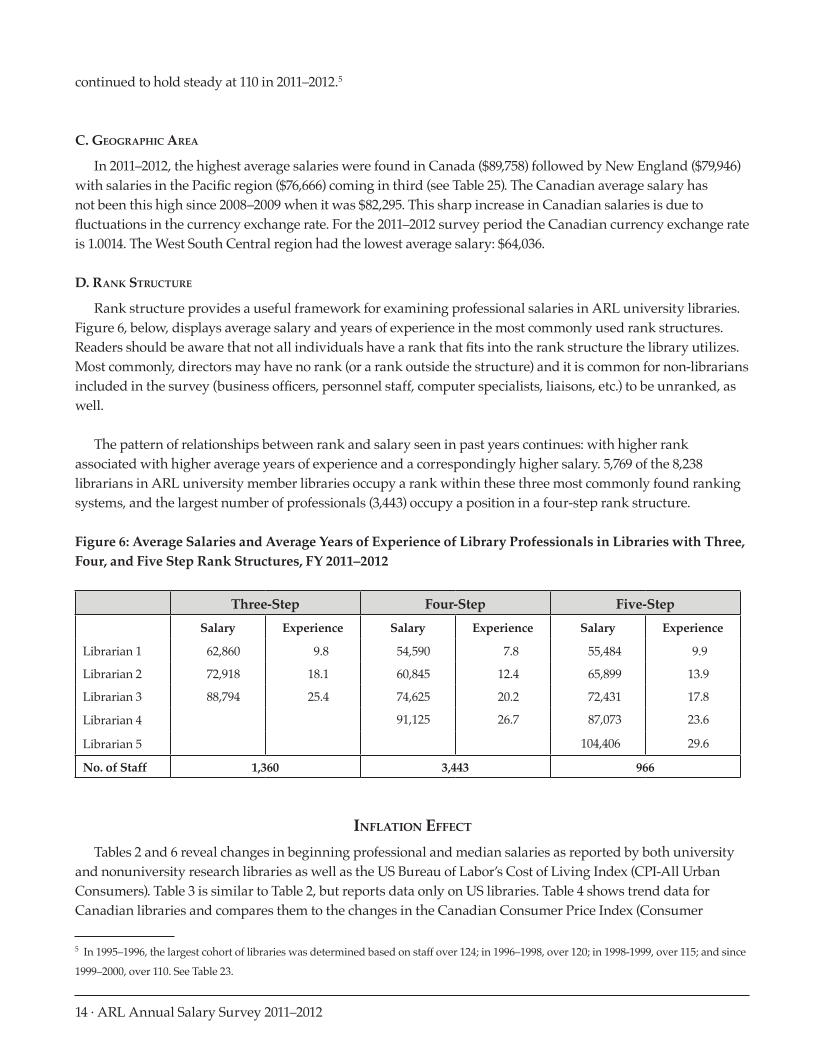14 · ARL Annual Salary Survey 2011–2012 continued to hold steady at 110 in 2011–2012.5 C. Geographic Area In 2011–2012, the highest average salaries were found in Canada ($89,758) followed by New England ($79,946) with salaries in the Pacific region ($76,666) coming in third (see Table 25). The Canadian average salary has not been this high since 2008–2009 when it was $82,295. This sharp increase in Canadian salaries is due to fluctuations in the currency exchange rate. For the 2011–2012 survey period the Canadian currency exchange rate is 1.0014. The West South Central region had the lowest average salary: $64,036. D. Rank Structure Rank structure provides a useful framework for examining professional salaries in ARL university libraries. Figure 6, below, displays average salary and years of experience in the most commonly used rank structures. Readers should be aware that not all individuals have a rank that fits into the rank structure the library utilizes. Most commonly, directors may have no rank (or a rank outside the structure) and it is common for non-librarians included in the survey (business officers, personnel staff, computer specialists, liaisons, etc.) to be unranked, as well. The pattern of relationships between rank and salary seen in past years continues: with higher rank associated with higher average years of experience and a correspondingly higher salary. 5,769 of the 8,238 librarians in ARL university member libraries occupy a rank within these three most commonly found ranking systems, and the largest number of professionals (3,443) occupy a position in a four-step rank structure. Figure 6: Average Salaries and Average Years of Experience of Library Professionals in Libraries with Three, Four, and Five Step Rank Structures, FY 2011–2012 Three-Step Four-Step Five-Step Salary Experience Salary Experience Salary Experience Librarian 1 62,860 9.8 54,590 7.8 55,484 9.9 Librarian 2 72,918 18.1 60,845 12.4 65,899 13.9 Librarian 3 88,794 25.4 74,625 20.2 72,431 17.8 Librarian 4 91,125 26.7 87,073 23.6 Librarian 5 104,406 29.6 No. of Staff 1,360 3,443 966 Inflation Effect Tables 2 and 6 reveal changes in beginning professional and median salaries as reported by both university and nonuniversity research libraries as well as the US Bureau of Labor’s Cost of Living Index (CPI-All Urban Consumers). Table 3 is similar to Table 2, but reports data only on US libraries. Table 4 shows trend data for Canadian libraries and compares them to the changes in the Canadian Consumer Price Index (Consumer 5 In 1995–1996, the largest cohort of libraries was determined based on staff over 124 in 1996–1998, over 120 in 1998-1999, over 115 and since 1999–2000, over 110. See Table 23.




























































































































